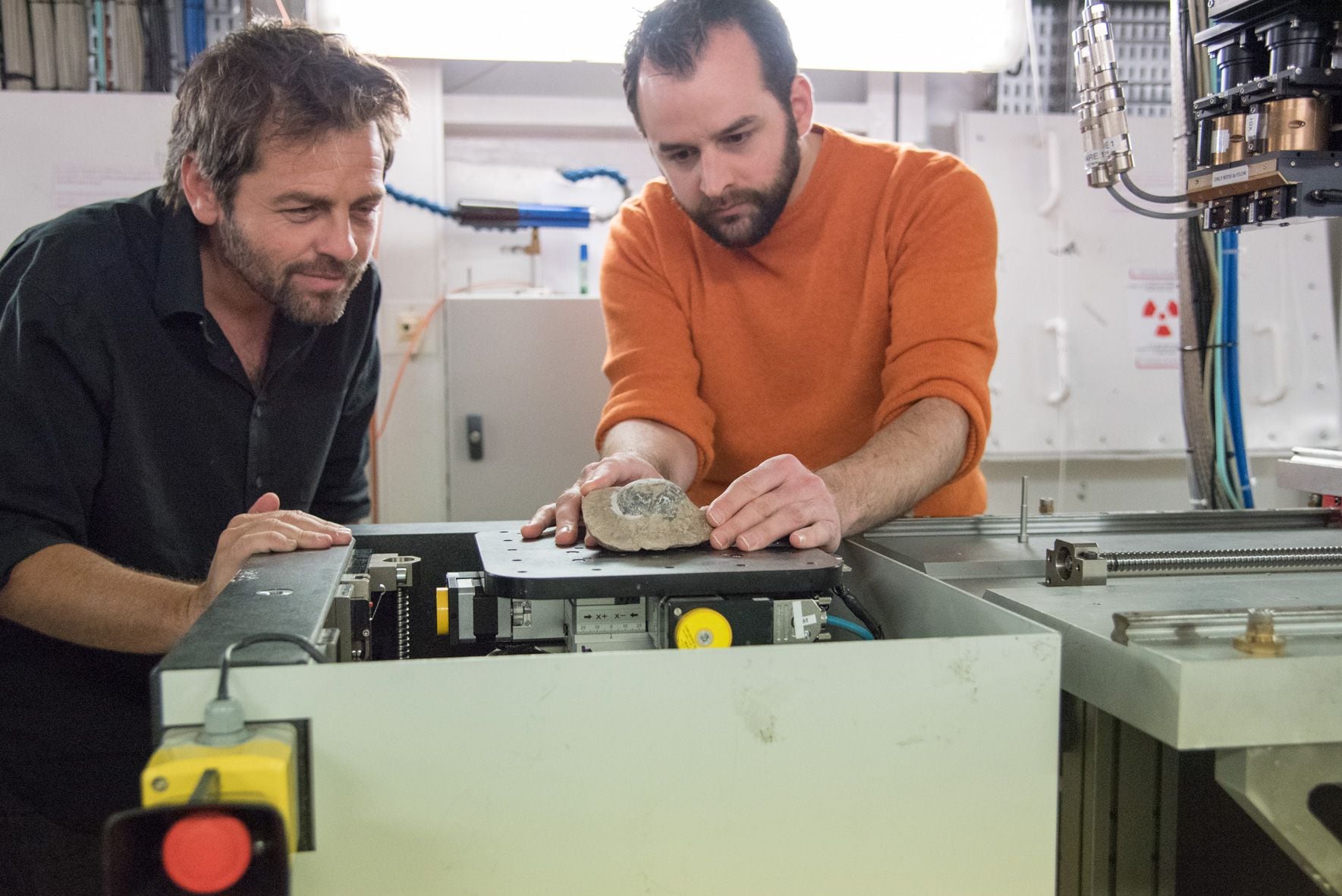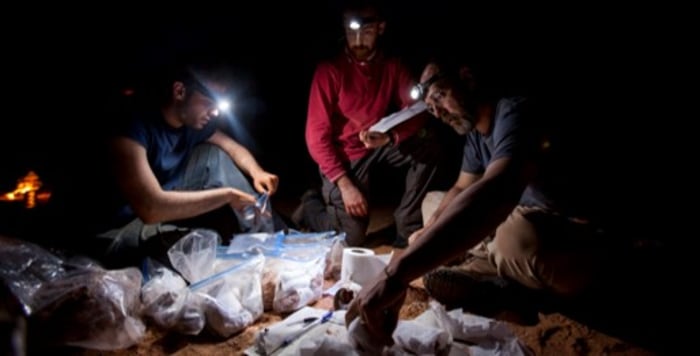
Steven Spielberg's film Jurassic Park, released in 1993, and his schools made the world pay more attention to dinosaurs. There was more interest in knowing who were the great animals that had inhabited the planet more than 65 million years ago. It struck a generation of children and adolescents who, like Matteo Fabbri, decided to be paleontologists and unravel the unknowns that still surround dinosaurs: they were land animals but did they adapt to moving in the water?
Fabbri now works at the Field Museum in Chicago, in the United States. Together with Argentine Diego Pol, from the Egidio Feruglio Museum (MEF) in Trelew, in the province of Chubut, Guillermo Navalón, of the Autonomous University of Madrid, Spain, and the University of Oxford, in the United Kingdom, and other researchers from Italy, the United States and Morocco, discovered evidence to assert that a group of dinosaurs did inhabit aquatic environments 100 million years ago. They published the finding in the journal Nature.
They are the Spinosaurs, which were the largest carnivorous dinosaurs. One of them stands out in the film Jurassic Park III, when the animal devours a weapons specialist and then has a fierce fight and kills a Tyrannosaurus rex. The first fossil remains of Spinosaurs were found in Egypt in the 1910s. They had long and narrow skulls like that of today's crocodiles, and they were distinguished by their thorns that formed like a candle.

In the field of dinosaur scholars there are also “cracks”. Over the past decade, there were some researchers who argued that Spinosaurs had been able to move in water. But there were also opponents who disapproved of these hypotheses.
In 2020, researchers from the United States found in the Sahara Desert, in Africa, an enormous number of teeth isolated from Spinosaurs in river deposits. “Upon finding the remains, the researchers said that it was unlikely that so many teeth of a land animal would accumulate in a river, considering that the teeth of crocodiles and other reptiles normally fall out when eating. It was one of several works that came out in recent years that generated an important debate about whether Spinosaurs were aquatic,” Dr. Diego Pol, a researcher at Conicet, told Infobae.
The tail of a Spinosaurus was also found, which was unknown and that showed a shape similar to that of aquatic crocodiles that use it for locomotion in water. “For each of these works in favor of the hypothesis, there was a replica of other paleontologists who rejected this interpretation for different reasons. They argued that the accumulation of teeth could have happened by chance because the animal fed on the river coast, but that it did not swim. Or that the tail would not have the hydrodynamic capacity to propel such a large animal. Let's think that we are talking about an animal about the size of a current elephant,” said Pol.

The team of Fabbri, Pol and other researchers began to search for answers. “The research began at the end of 2015,” said Dr. Fabbri from the United States in dialogue with Infobae. “It was a time when the debate about the ecology of Spinosaurs was beginning to become intense: although a study published in Science led by Nizar Ibrahim in 2014 showed several transformations of the legs and pelvic region of this animal that suggested a semi-aquatic ecology, other studies suggested a wading behavior for this animal. This meant that morphology alone was not enough to understand the ecology of this dinosaur and we decided to explore other indicators, such as bone density, to infer the biology of Spinosaurus.”
In fact, Fabbri clarified, “We realized that even amphibious animals, such as hippos and modern tapirs, show very little change in their skeletons, despite spending much of their time in the water. Therefore, we ask ourselves: what if we are underestimating the ecological variability among dinosaurs because we are so focused on anatomy?”
That concern led them to develop the largest bone density database ever built. It has 380 observations and 297 species of mammals and reptiles. “In terrestrial vertebrates, there were more than 30 events of evolution into the aquatic environment. That is to say that from terrestrial ancestors it evolves into aquatic animals. A famous example is the whales and dolphins that evolved from land forms,” said Dr. Pol.
“Often these habits of life are very difficult to infer in species that disappeared millions of years ago and that are very different from the current ones. There was an idea that the bones of animals moving under water are denser than those of terrestrial animals, but this had not been adequately studied. To do this work, we compiled a database of more than 200 species of terrestrial and aquatic animals to develop a statistical method to predict whether an animal is aquatic or terrestrial. We found that it can be predicted with more than 90% certainty. Thus, we can analyze the life habits of any species of extinct vertebrate with a certainty that did not exist until now”, emphasized Pol.
With regard to large dinosaurs, they had a great diversity of sizes and shapes and more than 150 million years of evolution. “By applying the new statistical method, we found that the only group of dinosaurs with bone density like that of aquatic animals were Spinosaurs. This means that Spinosaurs would be the exception to the rule, because all other dinosaurs are purely terrestrial,” said Pol.
If they moved in aquatic environments, were Spinosaurs in rivers or seas? asked Infobae. “The ancestors of Spinosaurs are bipedal terrestrial animals like all theropod dinosaurs. Famous carnivores such as Allosaurus would be similar in appearance to the ancestors of Spinosaurs. This family began to adapt to aquatic habitats but as far as we know about freshwater, rather than saltwater environments,” Pol replied.
So far the fossil remains of Spinosaurs have been found in Africa, but it does not mean that they do not exist in other regions of the world such as South America. “We still can't be sure that the Spinosaurs have been to Argentina, but there are remains of the family in Brazil. We think they have been to various places in South America, but for now the remains are incomplete and one of the great objectives in the coming years is to be able to find better remains of this enigmatic family,” said Pol.

When asked by Infobae, Rodolfo Coria, a dinosaur researcher and the Carmen Funes Museum in Plaza Huincul, in Neuquén, commented on the finding published in Nature: “The work is very good because it aims to interpret the ecological role of a very enigmatic group of non-avian dinosaurs such as spinosaurids. Possible aquatic habits, or at best, amphibians of this group, have long been suspected, practically since the discovery of the first Spinosaurus. However, there has never been such a meticulous analysis of the distribution of certain characteristics, such as the thickness of the bone walls of ribs and femurs, among various types of vertebrates and their possible link with aquatic habits.”
Also, said Coria, who did not participate in the study, “it is interesting that the authors propose a sequence of transformations in the skeleton linked to aquatic habits. Apparently, and based on the phylogenetic hypothesis proposed by the authors, the skull would have been transformed first and then followed by transformations in the spine. In summary, the published work gives empirical support to an ancient suspicion about the ecology of spinosaurids”.
After the discovery, there is now much more research. “A new question is what happened 100 million years ago for this group of dinosaurs to invade the aquatic environment while the rest of the dinosaur families remained terrestrial for more than 150 million years?” , pointed out Pol.

“Other questions arise about semi-aquatic species: how finely can we predict their habits with these methods? It is also worth studying whether adaptation to the aquatic environment in rivers or lagoons occurs differently than adaptations to the sea. We know that many things about the physiology and regulation of salt in the body must change, but we do not yet know completely that different modifications occur in the skeleton if the adaptation is to the freshwater or marine environment,” he added.
Fabbri is happy with the discovery: “We now know that a whole group of dinosaurs, that of the spinosaurids, were able to swim underwater. This is an obvious step towards a better understanding of how dinosaurs evolved and specialized in different ecological niches. This also means that we are probably underestimating the diversity of ecologies that characterize the evolution of non-avian dinosaurs,” he said. The researcher returned to his own past and acknowledged: “I saw Jurassic Park and fell in love with dinosaurs. I am part of a whole generation that was inspired by that film and decided to follow a path in this scientific discipline.”
KEEP READING:
Journey to the land of dinosaurs: what is the largest paleontological park in South America like
Últimas Noticias
Debanhi Escobar: they secured the motel where she was found lifeless in a cistern
Members of the Specialized Prosecutor's Office in Nuevo León secured the Nueva Castilla Motel as part of the investigations into the case

The oldest person in the world died at the age of 119
Kane Tanaka lived in Japan. She was born six months earlier than George Orwell, the same year that the Wright brothers first flew, and Marie Curie became the first woman to win a Nobel Prize

Macabre find in CDMX: they left a body bagged and tied in a taxi
The body was left in the back seats of the car. It was covered with black bags and tied with industrial tape
The eagles of America will face Manchester City in a duel of legends. Here are the details
The top Mexican football champion will play a match with Pep Guardiola's squad in the Lone Star Cup

Why is it good to bring dogs out to know the world when they are puppies
A so-called protection against the spread of diseases threatens the integral development of dogs




